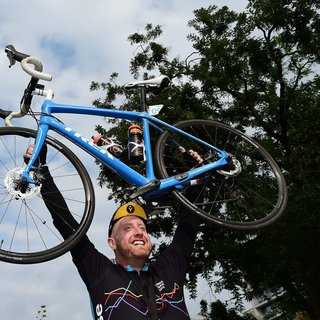Triathlon swimming guide
For many triathletes, swimming is the most difficult discipline to get to grips with. Here are five top tips to help get you started.
Learn to relax in water
Our natural inclination is to hold our breath the moment we lower our head in water. We have to first override this natural reaction by learning how to relax in water.
You can start before going anywhere near the pool or open water. Here's what to do:
- Using a sink or bowl of water, lower your face into the water and completely relax. Slowly and consistently exhale from your nose under water to produce a stream of small bubbles.
- When you surface to take your next breath, you should be calm and not need to be desperate for air.
- Take a breath in through your mouth (as you would in the pool), and again lower your face into the water.
- You should soon start to relax under water and learn how to manage your breathing. Focus fully on relaxation.
- Look to produce a steady, slow stream of bubbles. Work on extending the amount of time you stay submerged in the water for. You should not feel any discomfort.
Learn to bubble, bubble, breathe
Once you've mastered the basics of breathing under water, it's time to practise in the pool and develop a good breathing technique. This will stop you getting tired so quickly.
The bubble, bubble, breathe drill is one of the best for this. It will help to develop breathing relaxation and a bi-lateral breath that creates stroke balance.
Here's how you do it:
- Take a breath and on each of the following two strokes say 'bubble' into the water.
- On the third stroke, take a breath to the side and say 'breathe' to yourself (not out loud!)
- Repeat for the remainder of the lap.
This is likely to feel alien at first - especially breathing to your unfamiliar side. But stick with it. It will pay dividends in the long run. It is a great way to coordinate good exhalation with the timing required to breathe every two stokes - as opposed to every three.
Minimise the splash
The top swimmers produce very little splash, even when they're going quickly. To hone technique requires hours of practice, but body position and stroke technique is the key.
If you are doing it correctly, it should resemble something like this:
- Keep your body position as flat as you can . Aim to be streamlined in the water with a slight slope down to the hips to keep the leg kick underwater.
- Keep your head and spine as still and relaxed as possible. Instead, rotate your hips and shoulders to generate momentum through the water. Your head should only join the rotation when you want to breathe.
- Don’t start pulling back as soon as your hand is in the water. You should give yourself room to reach forward under the water before you start to bring your hand back to the body.
- Keep your legs close together with ankles relaxed and in a continuous motion.
- There’s no need to take large down and upbeats – a steady, small motion is fine. While the most pressure should be on your feet, remember to move your whole legs.
Get your glide on
The fewer strokes you take per length, the more proficient you become as a swimmer- and the less energy you use up. Elite swimmers like Michael Phelps can complete a length of a 25m pool in seven strokes (each hand entry counts as a stroke).
You should aim to keep yours below 20 by conserving momentum and stretching as far as you can with each stroke.
Once you're coming to the end of your glide, start the next stroke. Count how many strokes you do and do better with each length. The results will be worth it!
Practice, practice, practice
Most of us are fortunate enough to be able to walk to the shops without too much exertion. We should also be able to swim 400-500m at a similar intensity. As humans, we are fairly technically able at walking, but are inefficient as swimmers.
The key to swimming continuously without becoming tired comes down to technical proficiency. This is a case of practice, practice, practice.
You should aim to devote about 20% of your overall triathlon training to swimming. On average, that is the time split for nearly all triathletes.

